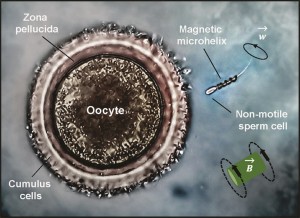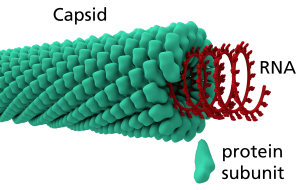When most people think of melting icebergs, they think of it as a negative effect of climate change, either because of the decrease of the albedo effect, the loss of habitat for animals such as polar bears, or the increase in sea level. As it turns out, a recent study suggests that the melting of icebergs may actually be countering the negative effects of climate change.
A press release published in the online magazine Science on January 11, 2016 describes the results determined from the study. It was found that icebergs contain bedrock from when they were once glaciers on land, and when these giant icebergs melt, they release nutrients such as iron into the nutrient-poor oceans of Antarctica, which causes massive phytoplankton blooms.

Phytoplankton blooms form around icebergs similar to this one that is forming around Greenland. Source: wikimedia
Phytoplankton, which are photosynthetic microorganisms at the base of the ocean’s food chain, have a positive impact on climate change because they take up the greenhouse gas CO2 in the atmosphere in order to grow. Satellite data collected from 2003 to 2013 show that these phytoplankton blooms occur up to hundreds of kilometers away from the icebergs, and can last up to a month after the iceberg passes.
A video released by Stanford University explains how these Antarctic phytoplankton blooms form:

The results from this study predict that the nutrients and minerals released by giant Antarctic icebergs (over 18 kilometers long) will absorb as much as 20% of atmospheric CO2 absorbed by all marine life in the southern seas. That amount is equal to between 44-146 million metric tons of CO2, which reduces a small amount of the 35.3 billion metric tons of CO2 burned by fossil fuels in 2013.
This press release presents important scientific research that could affect the way scientists view climate change. Melting icebergs will no longer be viewed in a strictly negative light, as the phytoplankton blooms surrounding melting icebergs absorb CO2 from the atmosphere, and are acting as a negative feedback on the CO2 humans are releasing into the atmosphere from burning fossil fuels. These blooms can also have a positive impact on the many species that feed off of phytoplankton.
According to the article summarized in the press release, these phytoplankton blooms absorb only a very small amount of the total atmospheric CO2. Is it enough to substantially offset the amount of CO2 being pumped into the atmosphere by fossil fuels? No predictions are offered in either the press release or in the article itself. As this is currently the only study being done on the beneficial effects of melting icebergs, we will need to stay tuned for further research in order to see if there truly are positive impacts on climate change from melting icebergs in the Antarctic.
– Emma Peachey, January 18, 2016







